The Impact of the Observation Data Assimilation on Atmospheric Reanalyses over Tibetan Plateau and Western Yunnan-Guizhou Plateau
Abstract
1. Introduction
2. Data and Methodology
3. Major Findings
3.1. Mean Profiles
3.2. Mean Biases and RMSEs
3.2.1. Horizontal Wind
3.2.2. Temperature
3.2.3. Specific Humidity
3.3. Variations of Uncertainty and Bias
4. Conclusions
Author Contributions
Funding
Acknowledgments
Conflicts of Interest
References
- Ye, D. Some characteristics of the summer circulation over the Qinghai-Xizang (Tibet) Plateau and its neighborhood. Bull. Am. Meteor. Soc. 1981, 62, 14–19. [Google Scholar] [CrossRef]
- Ye, D.; Wu, G. The role of the heat source of the Tibetan Plateau in the general circulation. Meteor. Atmos. Phys. 1998, 67, 181–198. [Google Scholar] [CrossRef]
- Molnar, P.; Boos, W.R.; Battisti, D.S. Orographic controls on climate and paleoclimate of Asia: Thermal and mechanical roles for the Tibetan Plateau. Annu. Rev. Earth Planet. Sci. 2010, 38, 77–102. [Google Scholar] [CrossRef]
- Bao, X.; Zhang, F.; Sun, J. Diurnal variations of warm season precipitation east of the Tibetan Plateau over China. Mon. Weather Rev. 2011, 139, 2790–2810. [Google Scholar] [CrossRef]
- Si, D.; Ding, Y.Y. Decadal change in the correlation pattern between the Tibetan Plateau winter snow and the East Asian summer precipitation during 1979–2011. J. Clim. 2013, 26, 7622–7634. [Google Scholar] [CrossRef]
- Hu, L.; Deng, D.; Xu, X.; Zhao, P. The regional differences of Tibetan convective systems in boreal summer. J. Geophys. Res. Atmos. 2017, 122, 7289–7299. [Google Scholar] [CrossRef]
- Shi, Z.; Sha, Y.; Liu, Y.X. Effect of Yunnan—Guizhou topography at the southeastern Tibetan Plateau on the Indian monsoon. J. Clim. 2017, 30, 1259–1272. [Google Scholar] [CrossRef]
- Shi, Z.; Sha, Y.; Liu, X.; Xie, X.; Li, X. Effect of marginal topography around the Tibetan Plateau on the evolution of central Asian arid climate: Yunnan—Guizhou and Mongolian Plateaux as examples. Clim. Dyn. 2019. [Google Scholar] [CrossRef]
- Feng, X.; Liu, C.; Rasmussen, R.; Fan, G. A 10-yr climatology of Tibetan Plateau vortices with NCEP Climate Forecast System Reanalysis. J. Appl. Meteor. Climatol. 2014, 53, 34–46. [Google Scholar] [CrossRef]
- Gerlitz, L.; Conrad, O.; Thomas, A.; Böhner, J. Warming patterns over the Tibetan Plateau and adjacent lowlands derived from elevation-and bias-corrected ERA-Interim data. Clim. Res. 2014, 58, 235–246. [Google Scholar] [CrossRef]
- Gao, Y.; Xu, J.; Chen, D. Evaluation of WRF mesoscale climate simulations over the Tibetan Plateau during 1979–2011. J. Clim. 2015, 28, 2823–2841. [Google Scholar] [CrossRef]
- Cuo, L.; Zhang, Y. Spatial patterns of wet season precipitation vertical gradients on the Tibetan Plateau and the surroundings. Sci. Rep. 2017, 7, 5057. [Google Scholar] [CrossRef] [PubMed]
- Bao, X.; Zhang, F. Evaluation of NCEP–CFSR, NCEP–NCAR, ERA-Interim, and ERA-40 reanalysis datasets against independent sounding observations over the Tibetan Plateau. J. Clim. 2013, 26, 206–214. [Google Scholar] [CrossRef]
- Bao, X.; Zhang, F. How Accurate Are Modern Atmospheric Reanalyses for the Data-Sparse Tibetan Plateau Region? J. Clim. 2019, 32, 7153–7172. [Google Scholar] [CrossRef]
- Lindsay, R.W.; Wensnahan, M.; Schweiger, A.; Zhang, J. Evaluation of seven different atmospheric reanalysis products in the Arctic. J. Clim. 2014, 27, 2588–2606. [Google Scholar] [CrossRef]
- Fujiwara, M.; Wright, J.S.; Manney, G.L.; Gray, L.J.; Anstey, J.; Birner, T.; Homeyer, C.R. Introduction to the SPARC Reanalysis Intercomparison Project (S-RIP) and overview of the reanalysis systems. Atmos. Chem. Phys. 2017, 17, 1417–1452. [Google Scholar] [CrossRef]
- Kalnay, E.; Kanamitsu, M.; Kistler, R.; Collins, W.; Deaven, D.; Gandin, L.; Zhu, Y. The NCEP/NCAR 40-Year Reanalysis Project. Bull. Am. Meteorol. Soc. 1996, 77, 437–471. [Google Scholar] [CrossRef]
- Bosilovich, M.G.; Robertson, F.R.; Chen, J. Global Energy and Water Budgets in MERRA. J. Clim. 2011, 24, 5721–5739. [Google Scholar] [CrossRef]
- Robertson, F.R.; Bosilovich, M.G.; Chen, J.; Miller, T.L. The Effect of Satellite Observing System Changes on MERRA Water and Energy Fluxes. J. Clim. 2011, 24, 5197–5217. [Google Scholar] [CrossRef]
- Robertson, F.R.; Bosilovich, M.G.; Roberts, J.B.; Reichle, R.H.; Adler, R.; Ricciardulli, L.; Berg, W.; Huffman, G.J. Consistency of Estimated Global Water Cycle Variations over the Satellite Era. J. Clim. 2014, 27, 6135–6154. [Google Scholar] [CrossRef][Green Version]
- Wang, A.; Zeng, X. Evaluation of multireanalysis products with in situ observations over the Tibetan Plateau. J. Geophys. Res. 2012, 117, D05102. [Google Scholar] [CrossRef]
- Zhao, T.; Wang, J.; Dai, A. Evaluation of atmospheric precipitable water from reanalysis products using homogenized radiosonde observations. J. Geophys. Res. 2015, 120. [Google Scholar] [CrossRef]
- Dong, Y.; Li, G.; Yuan, M.; Xie, X. Evaluation of Five Grid Datasets against Radiosonde Data over the Eastern and Downstream Regions of the Tibetan Plateau in Summer. Atmosphere 2017, 8, 56. [Google Scholar] [CrossRef]
- Long, C.S.; Fujiwara, M.; Davis, S.; Mitchell, D.M.; Wright, C.J. Climatology and interannual variability of dynamic variables in multiple reanalyses evaluated by the SPARC Reanalysis Intercomparison Project (S-RIP). Atmos. Chem. Phys. 2017, 17, 14593–14629. [Google Scholar] [CrossRef]
- Davis, S.M.; Hegglin, M.I.; Fujiwara, M.; Dragani, R.; Harada, Y.; Kobayashi, C.; Tegtmeier, S. Assessment of upper tropospheric and stratospheric water vapour and ozone in reanalyses as part of S-RIP. Atmos. Chem. Phys. 2017, 17, 12743–12778. [Google Scholar] [CrossRef]
- Kobayashi, S.; Ota, Y.; Harada, Y.; Ebita, A.; Moriya, M.; Onoda, H.; Onogi, K.; Kamahori, H.; Kobayashi, C.; Endo, H.; et al. The JRA-55 Reanalysis: General Specifications and Basic Characteristics. J. Meteorol. Soc. Jpn. 2015, 93, 5–48. [Google Scholar] [CrossRef]
- Compo, G.P.; Whitaker, J.S.; Sardeshmukh, P.D.; Matsui, N.; Allan, R.J.; Yin, X.; Brönnimann, S. The Twentieth Century Reanalysis Project. Q. J. R. Meteorol. Soc. 2011, 137, 1–28. [Google Scholar] [CrossRef]
- Kobayashi, C.; Endo, H.; Ota, Y.; Kobayashi, S.; Onoda, H.; Harada, Y.; Onogi, K.; Kamahori, H. Preliminary results of the JRA-55C, an atmospheric reanalysis assimilating conventional observations only. Sola 2014, 10, 78–82. [Google Scholar] [CrossRef]
- Chen, G.; Iwasaki, T.; Qin, H.; Sha, W. Evaluation of the Warm-Season Diurnal Variability over East Asia in Recent Reanalyses JRA-55, ERA-Interim, NCEP CFSR, and NASA MERRA. J. Clim. 2014, 27, 5517–5537. [Google Scholar] [CrossRef]
- Zhang, R.; Xu, X.; Koike, T.; Ma, Y.; Yang, K. A China-Japan cooperative JICA atmospheric observing network over the Tibetan Plateau (JICA/Tibet Project): An overview. J. Meteorol. Soc. Jpn. 2012, 90C, 1–16. [Google Scholar] [CrossRef]
- NaSh, J.; Oakley, T.; Vomel, H.; Wei, L. WMO Intercomparison of High Quality Radiosonds Systems, Yangjiang, China, 12 July–3 August 2010; Instruments and Observing Methods Report No. 107; World Meteorological Organization: Geneva, Switzerland, 2011; 248p. [Google Scholar]
- Simmons, A.J.; Untch, A.; Jakob, C.; Kållberg, P.; Undén, P. Stratospheric water vapour and tropical tropopause temperatures in ECMWF analyses and multi-year simulations. Q. J. R. Meteorol. Soc. 1999, 125, 353–386. [Google Scholar] [CrossRef]
- Dee, D.P.; Uppala, S.M.; Simmons, A.J.; Berrisford, P.; Poli, P.; Kobayashi, S.; Bechtold, P. The ERA-Interim reanalysis: Configuration and performance of the data assimilation system. Q. J. R. Meteorol. Soc. 2011, 137, 553–597. [Google Scholar] [CrossRef]
- Guo, Y.; Zhang, S.; Yan, J.; Chen, Z.; Xin, R. A comparison of atmospheric temperature over China between radiosonde observations and multiple reanalysis datasets. J. Meteor. Res. 2016, 30, 242–257. [Google Scholar] [CrossRef]
- He, J.; Zhang, F.; Chen, X.; Bao, X.; Chen, D.; Kim, H.M.; Ou, T. Development and evaluation of an ensemble-based data assimilation system for regional reanalysis over the Tibetan Plateau and surrounding regions. J. Adv. Modeling Earth Syst. 2019, 11, 2503–2522. [Google Scholar] [CrossRef]
- Diniz, F.L.R.; Todling, R. Assessing the impact of observations in a multi-year reanalysis. Q. J. R. Meteorol. Soc. 2019, 146, 724–747. [Google Scholar] [CrossRef]
- Diniz, F.L.R.; Todling, R.; Herdies, D.L. A brief assessment of the impact of nearly 40 years of assimilated observations over the Amazon basin. Earth Space Sci. 2020, 7, e2019EA000779. [Google Scholar] [CrossRef]
- Nygård, T.; Vihma, T.; Birnbaum, G.; Hartmann, J.; King, J.; Lachlan-Cope, T.; Ladkin, L.; Lüpkes, C.; Weissc, A. Validation of eight atmospheric reanalyses in the Antarctic Peninsula region. Q. J. R. Meteorol. Soc. 2016, 142, 684–692. [Google Scholar] [CrossRef]
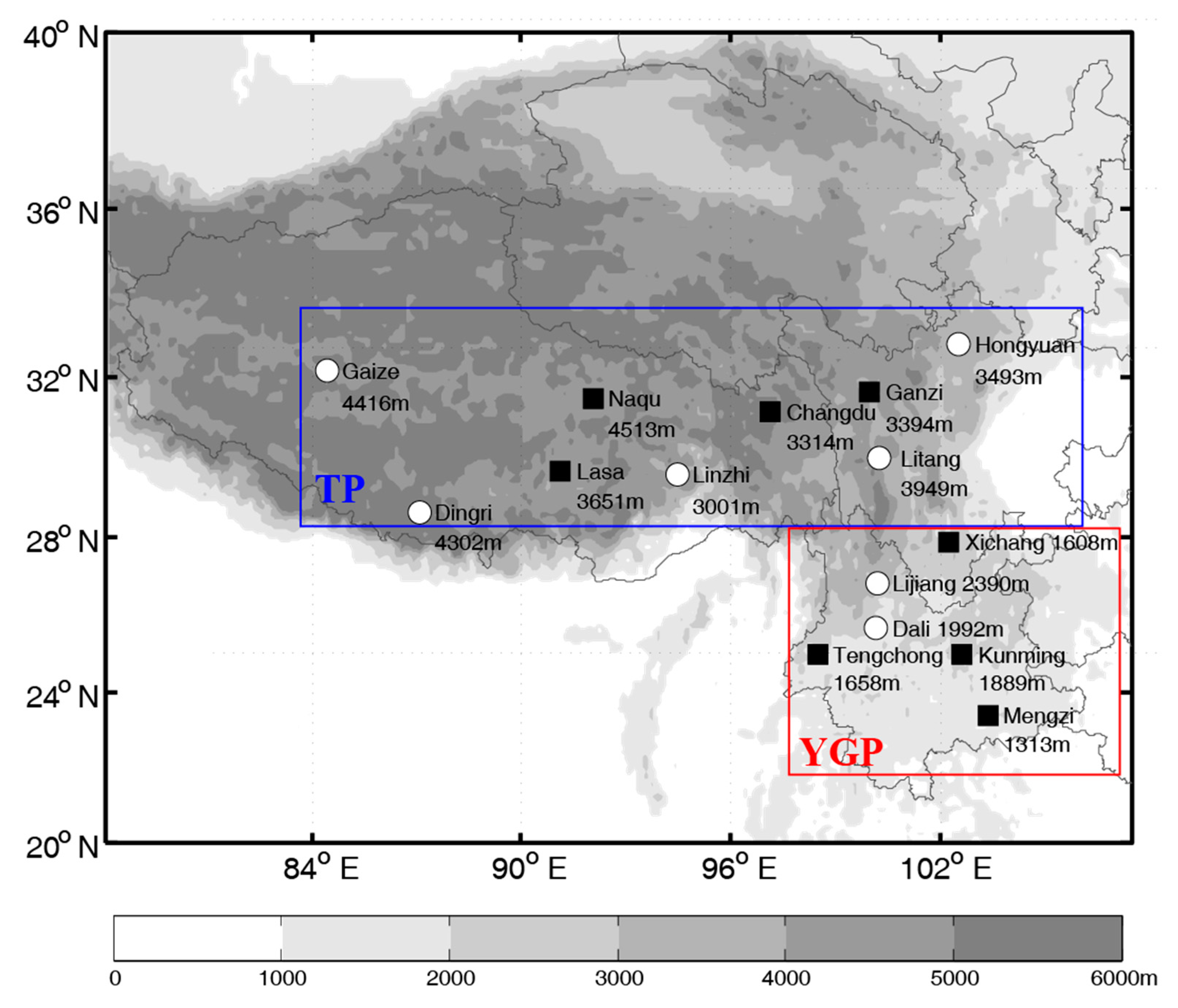
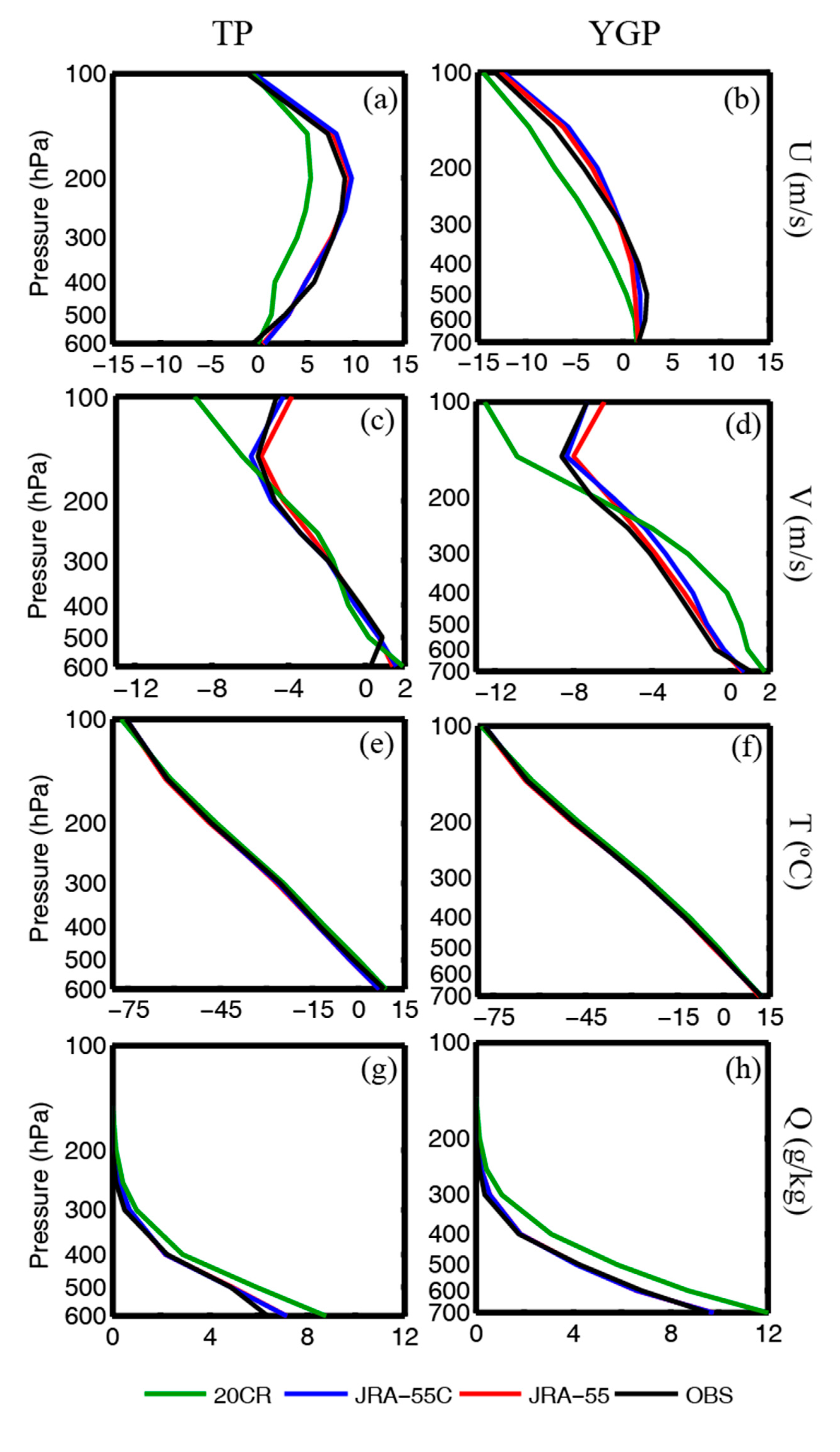
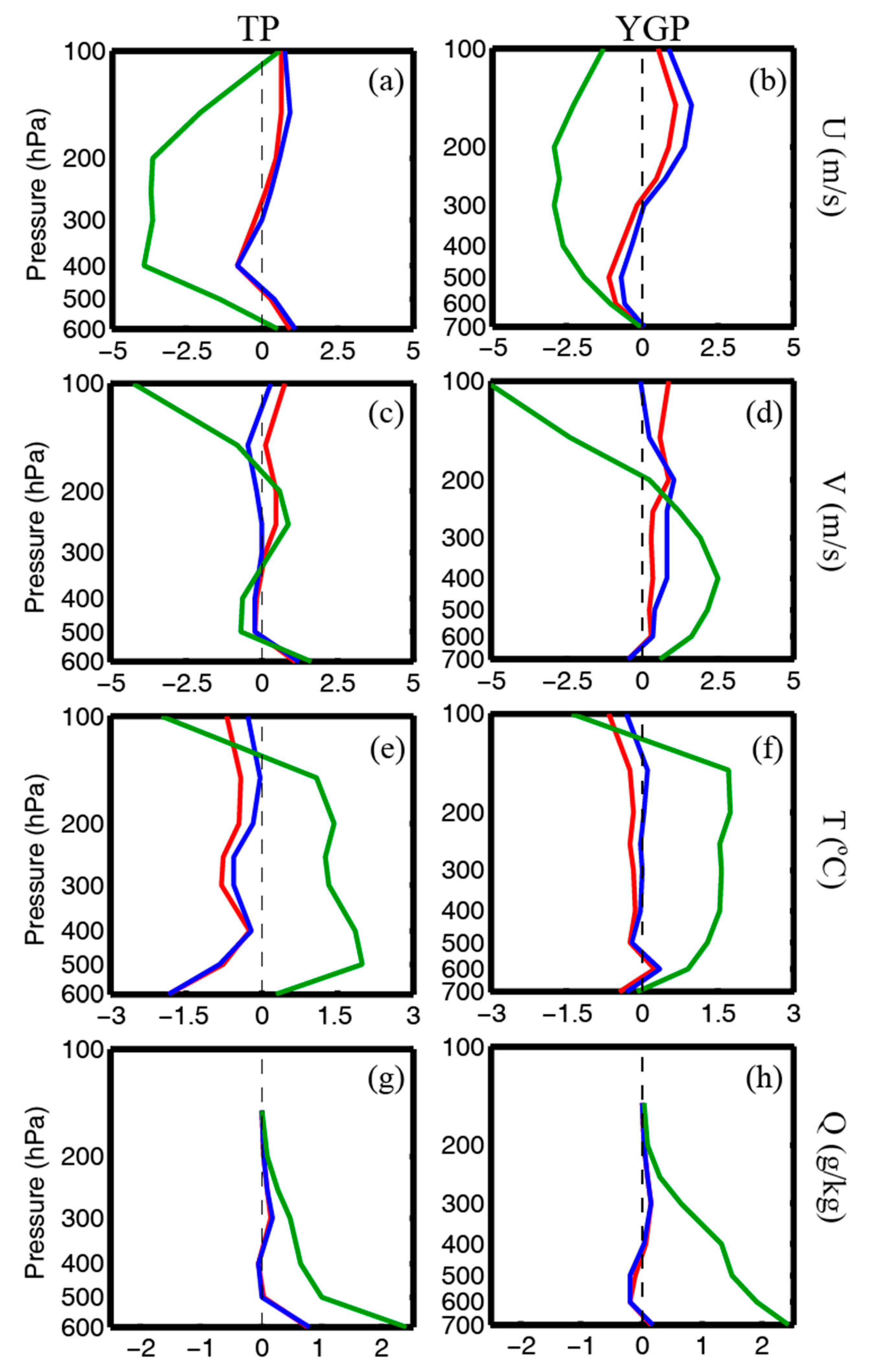
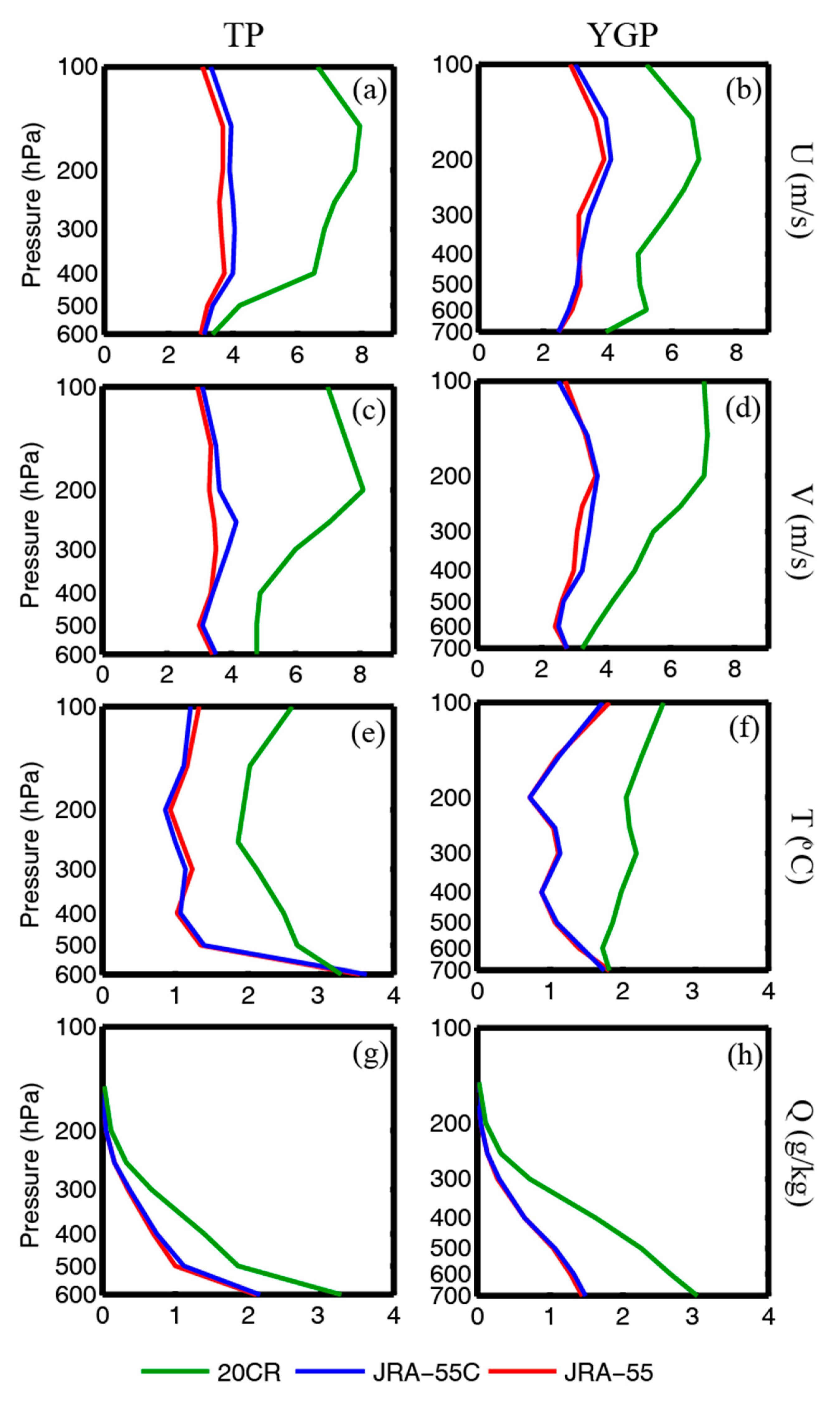
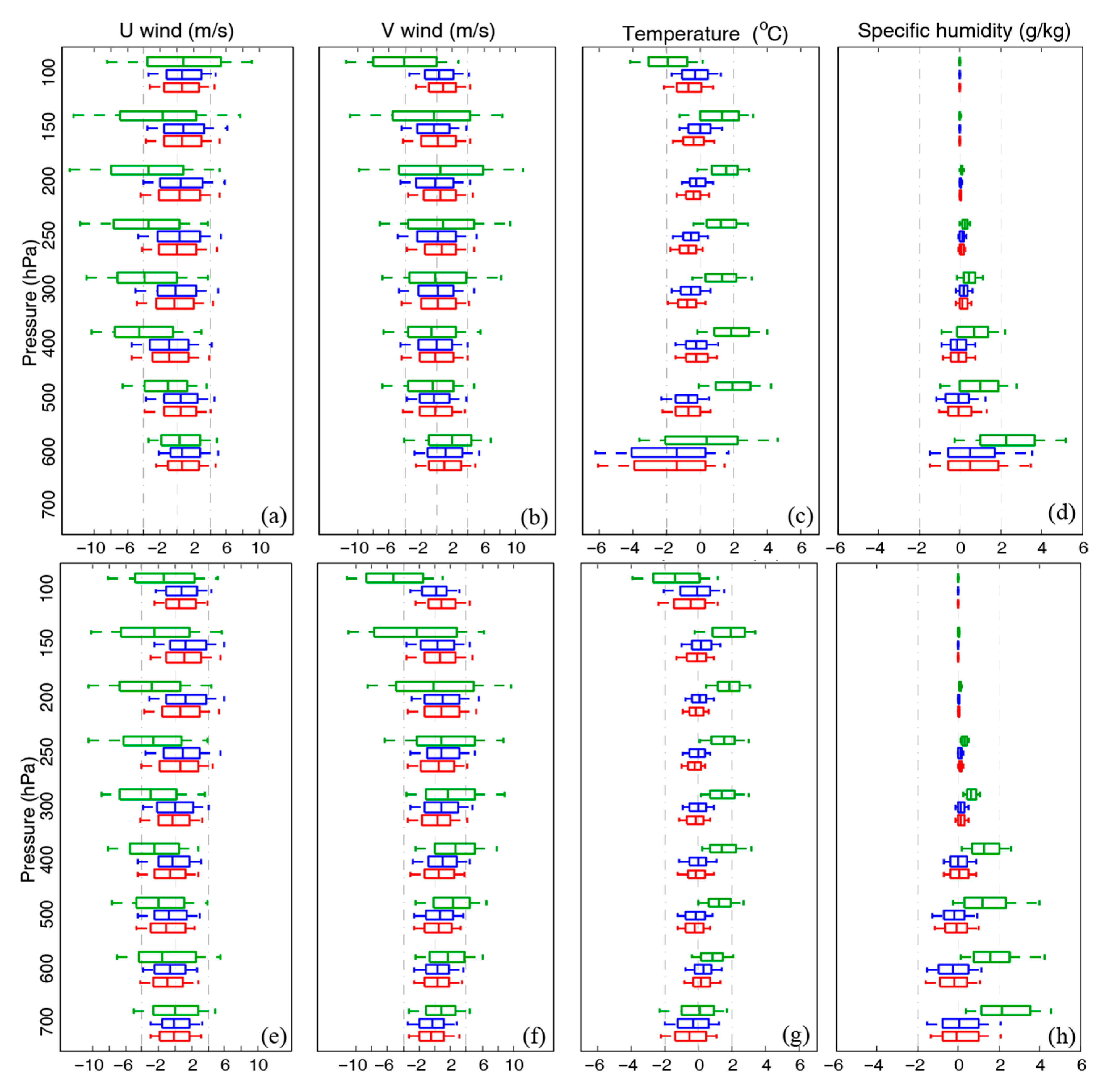
Publisher’s Note: MDPI stays neutral with regard to jurisdictional claims in published maps and institutional affiliations. |
© 2020 by the authors. Licensee MDPI, Basel, Switzerland. This article is an open access article distributed under the terms and conditions of the Creative Commons Attribution (CC BY) license (http://creativecommons.org/licenses/by/4.0/).
Share and Cite
Bao, X.; Zhang, F.; Zhao, Y.; Chen, Y. The Impact of the Observation Data Assimilation on Atmospheric Reanalyses over Tibetan Plateau and Western Yunnan-Guizhou Plateau. Atmosphere 2021, 12, 38. https://doi.org/10.3390/atmos12010038
Bao X, Zhang F, Zhao Y, Chen Y. The Impact of the Observation Data Assimilation on Atmospheric Reanalyses over Tibetan Plateau and Western Yunnan-Guizhou Plateau. Atmosphere. 2021; 12(1):38. https://doi.org/10.3390/atmos12010038
Chicago/Turabian StyleBao, Xinghua, Fuqing Zhang, Yang Zhao, and Yueli Chen. 2021. "The Impact of the Observation Data Assimilation on Atmospheric Reanalyses over Tibetan Plateau and Western Yunnan-Guizhou Plateau" Atmosphere 12, no. 1: 38. https://doi.org/10.3390/atmos12010038
APA StyleBao, X., Zhang, F., Zhao, Y., & Chen, Y. (2021). The Impact of the Observation Data Assimilation on Atmospheric Reanalyses over Tibetan Plateau and Western Yunnan-Guizhou Plateau. Atmosphere, 12(1), 38. https://doi.org/10.3390/atmos12010038





